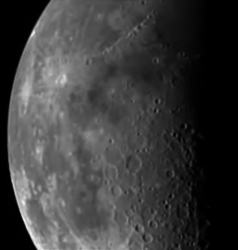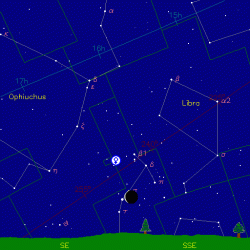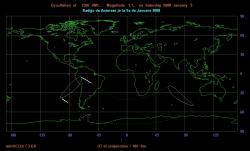As we kick off the year 2008, Comet Tuttle is putting on a nice show for backyard skywatchers. It had not been seen since 1994, but you'll have an excellent opportunity to pick it up with binoculars or small telescopes during the next two weeks.
Tuttle can even be glimpsed by sharp-eyed observers under pristine skies without any optical aids, for it is one of the brightest of the short-period comets, those that orbit the sun often enough to be seen again and again from Earth and identified as such.
And speaking of short-period comets, Comet Holmes continues to delight observers more than two months after its stupendous explosion to naked-eye visibility.
Discovery
As we all know, Halley's was the first comet-to be recognized as periodic, but it had been seen on many previous returns before Edmund Halley announced that fact in the year 1705. Similarly, although Encke's comet was discovered in 1786, it was observed on three more returns before Johann Franz Encke determined that it had an orbital period of 3.3-years.
The object that we today call Comet Tuttle had a similar history.
On Jan. 9, 1790, the renowned Parisian comet hunter Pierre Méchain discovered a fairly bright telescopic comet in the western evening sky. His friend and rival Charles Messier described it on the following night as resembling an unresolved star cluster or nebula without a nucleus. It was followed for just over three weeks; just not enough time for a sufficient number of observations to determine an accurate orbit.
Astronomers assumed that the object was traveling in a parabolic orbit and would never be seen again, and entered the literature simply as "Comet 1790 II." It wasn't to be seen again for nearly 70-years.
Tuttle's turn
Horace P. Tuttle, an assistant at Harvard College Observatory, discovered three comets by telescope during the year 1858. Tuttle found the first of them on Jan. 4 in the constellation Andromeda. Still approaching the perihelion point of its orbit (its least distance from the sun), the comet was favorably placed relative to the Earth, and this made possible a long series of positional measurements.
Comet Tuttle was brightest during February at about magnitude 7, meaning it was just below the threshold of naked eye visibility, though a relatively easy object to see with binoculars or a small telescope.
Tuttle himself was among the first to suggest that his object was identical with Comet 1790 II. A 13.7-year period was proposed by several astronomers, and it soon became clear that Comet Tuttle of 1858 had been missed at four intervening apparitions. At three of those returns (1803, 1817, and 1844) it was too close to the sun in the sky to be seen, while conversely, in 1830 it should have been an easy object in the morning sky but was somehow missed.
Comet Tuttle became the eighth comet to be recognized as a periodic object hence it is now designated as 8P/Tuttle.
The perihelion distance of 8P/Tuttle places it just outside of the Earth's orbit at 95.5 million miles (153.6 million kilometers). Also, around Dec. 22 of each year the Earth passes through the dusty trail left behind by the comet from its previous visits. This encounter gives rise to an annual display of meteors known as the Ursids, which appear to diverge from near the bright star Kochab in the bowl of the Little Dipper.
Because 8P/Tuttle was observed at each return following its 1858 rediscovery except in 1953, this time around will go down in the record books as its 12th observed apparition. And as it turns out, this apparition will be among its very best.
Where and when to look
On New Year's Day, 8P/Tuttle passed closest to Earth; a distance of 23.5 million miles (37.8 million kilometers). Although it is now slowly moving away from the Earth, it will continue to slowly approach the sun, passing closest to it on Jan. 27. Comets are most visible when they near the sun, which lights up material that boils off the comet.
So, during these next two weeks, the comet will hold nearly steady in brightness at around magnitude 6. For those blessed with clear, dark skies far from significant light pollution, the comet might be even glimpsed with the unaided eye. But good binoculars or a small telescope will easily bring 8P/Tuttle into view if you know where to train them; it should appear as a small fuzzy star possibly sporting a faint, narrow tail.
The comet will be situated against the rather dim stars that compose the so-called "watery region" of the sky, passing through eastern Pisces (the fishes) into Cetus (the whale) during the night of Jan. 6-7. On that night, it will lie not far to the west from one of the brightest stars in Pisces: fourth magnitude, Al Rischa, located at the point where the two fish are tied. In fact, the name comes from the Arabic word for "cord."
For the next couple of weeks both Pisces and Cetus can be conveniently found well up in the southern sky between 6 to 8 p.m. local standard time.
Comet 8P/Tuttle will appear to skid south in its orbit against the background stars of these two constellations. After moving through Cetus, 8P/Tuttle will pass into the dim, shapeless constellation of Fornax (the furnace) on Jan. 16. It will continue to plunge south thereafter, gradually becoming unfavorably placed for viewers in the Northern Hemisphere, although those living south of the equator will be able to follow the now fading comet right on into February.
A reminder about Comet Holmes!
While the spotlight is now on Comet Tuttle, we should not forget about our old friend, Comet Holmes which continues to be dimly visible to the unaided eye as a diffuse, circular cloud, roughly twice the apparent diameter of the moon against the stars of the constellation Perseus.
This comet was no brighter than magnitude 17 in mid-October — that's about 25,000 times fainter than the faintest star that can normally be seen without any optical aid. But late on Oct. 23, the comet's brightness suddenly rocketed all the way up to magnitude 2.5, brightening nearly one million times in less than 24 hours!
In attempting to explain why Comet Holmes exploded, comet expert, John Bortle suggested that this comet's nucleus consists of low-density material that, over time developed into a large region with a very tenuous structure, like a honeycomb. At some point, the highly fragile bonds connecting the honeycomb of material reached a failing point and a sudden crushing collapse occurred, expelling a gigantic volume of dust into space, making this dim comet suddenly appear impressively bright.
Back in 1892, Comet Holmes suffered two major outbursts separated by about 75 days. This leads to the question as to whether this comet will undergo a similar "cosmic aftershock" in the wake of its recent late October explosion.
Bortle thinks it's a possibility, based on the theory that there may be a large amount of residual instability which might lead to a second major collapse of material on the comet nucleus. If what happens now parallels what happened in 1892, another possible explosive outburst may be imminent, so it might be wise to keep a close watch on Comet Holmes in the coming days ahead.











